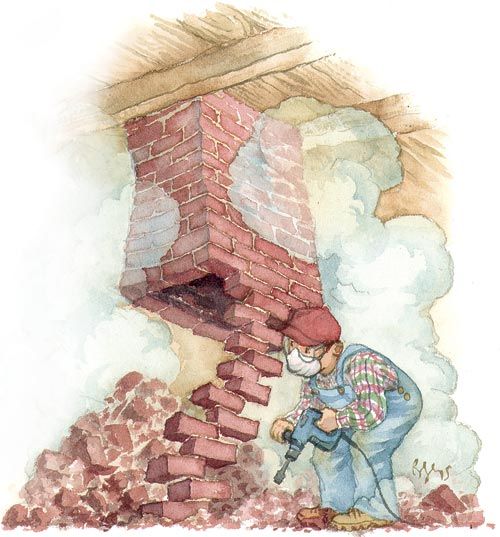Brick by Brick
Great moments in building history: An interesting method for chimney demolition

When I started expanding and renovating my home, I didn’t have much knowledge of building. I had to fall back on books and the advice of my neighbor, a self-professed jack-of-all-trades.
I avoided most of his dubious advice, but I fell for one suggestion. My neighbor mentioned that the best—and the only—way to take down a brick chimney was to go to the base and start smashing it, letting it collapse into the house and repeating as necessary.
My neighbor moved away, and I accumulated a lot of experience. But I never reconsidered the chimney-demolition idea. Years later, when it came time to demolish the chimney, my neighbor’s instructions were lurking like a landmine in the back of my head.
Early one morning, I climbed up on the roof to rip through the flashing and roof sealer; then I went to the basement. The neighborly instruction I’d once received specified that the chimney should be demolished with a sledgehammer, but over the years, I’d acquired a rotary demolition hammer, which seemed like an even better tool for the job. With a small tingle of excitement, I started hammering out bricks. First, I created a small hole, then I worked around the chimney; finally, I was left with a chimney supported from a height of 3 ft. by a single stack of zigzagging bricks.
I pondered that narrow neck of bricks for a while. I certainly didn’t want to be a mere 18 in. or 24 in. away from the chimney when it came crashing down, but that was the distance from trigger to business end of the demolition hammer. I pondered a bit more, then moved back a few steps, grabbed the sledgehammer, and swung at the fragile column of brick. Almost as soon as I connected, the weight-bearing bricks collapsed, and the chimney came roaring straight down, exactly as promised. Perhaps this method wasn’t as sketchy as I’d feared. With confidence, I renewed my attack on the chimney. Again, I worked my way three-quarters around it, leaving another neck of bricks, and again, I stepped back and swung the sledgehammer. Another satisfying roar ensued. I went back for a third round—but this time, things went differently.
Previously, the chimney had come plunging straight down. This time, the chimney came down, landed, then tilted sideways and collapsed onto the basement floor. I managed to jump back and avoid the masonry as it fell. I was happy that the chimney had come down so easily, but then I realized that removing two vertical feet of chimney three times probably didn’t account for the totality of a three-story structure.
I grabbed a shiny bit of metal and stepped toward the chimney, holding the metal low and looking down to see the reflection. Most of the chimney was still in the shaft.
I grabbed the reciprocating saw, the demo hammer, a pry bar, and an extension cord and raced up to my kitchen. Without regret, I started ripping down the wall that enclosed the chimney. When several square feet of chimney were exposed, I saw the problem: The bottom edge of the brick column had shifted a fraction of an inch to one side as it fell, and it landed on a summer beam of the house. I couldn’t shift it off with the pry bar, but I could start breaking the mortar between the bricks and thus try to loosen the thing enough so that it could shift on its own.
At first, this method had no effect; then, I thought I detected a bit of movement; then, the chimney started accelerating downward—with the tip of the demo hammer’s chisel pinched between two bricks. As the tip got closer and closer to the floor, I kept pulling back on the hammer, yanking it free with only a few inches of space before the tool was pulled onto the linoleum.
I spent a few more hours smashing chimney, and then most of the day hauling away the bricks and masonry liner. By the time I was done returning the place to livable condition, the sun was setting. I paused to admire my handiwork, looked up through the hole in my roof, saw the late-afternoon sky—and noticed the storm clouds building. But that’s another story.
Drawing by Jackie Rogers
Fine Homebuilding Recommended Products
Fine Homebuilding receives a commission for items purchased through links on this site, including Amazon Associates and other affiliate advertising programs.

Handy Heat Gun

Affordable IR Camera

8067 All-Weather Flashing Tape


























